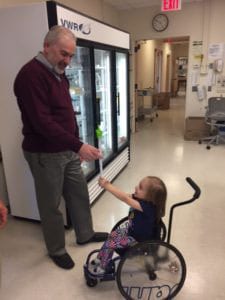By Daniel Dunaief

The prognosis hit Dianne Larson of Middle Island hard. Within three weeks, anxiety attacks, a lack of sleep and fear caused her weight to plummet from 135 to 120 pounds. She found out her daughter Emma, who was 17 months old at the time, had a potentially fatal genetic condition called spinal muscular atrophy in which the motor nerve cells of the spinal cord progressively weaken. Normally, the SMN1 gene produces the survival of motor neuron protein, which, as its name suggests, helps maintain motor neurons. People with SMA, which has four types and severity, produce a lower amount of the functional protein.
“My mind went to the darkest of dark places,” said Larson, whose daughter couldn’t crawl or sit up to eat. “There was no hope. There was nothing I could do.”
At the time of Emma’s diagnosis, there was no treatment for a disease that is the leading genetic cause of death among infants and affects about 1 in 10,000 newborns. Thanks to the work of Adrian Krainer, a professor and program chair of cancer and molecular biology at Cold Spring Harbor Laboratory, that changed early enough to alter the expectations for Emma and children around the world battling a genetic condition that causes progressive weakness and can make moving and even breathing difficult.
Turning to a back up gene called SMN2, Krainer hoped to fix a problem with the way that gene is spliced. On SMN2, exon 7 is normally skipped and the resulting protein has a different sequence at the end. Krainer developed an antisense olignocleotide that binds to a sequence in the intro following exon 7, blocking the splicing receptor. The treatment, which is called Spinraza, helps guide the splicing machinery, which carries out one of the steps in gene expression that is necessary to build a functional protein.

Larson had heard of Krainer’s work and was eager to see if his success with animal models of the disease would translate for humans. As soon as Emma reached her second birthday, Larson enrolled her daughter in a clinical trial for Spinraza. After her daughter had a few shots, Larson was stunned by the change. “I was in the master bedroom and she was in the den and I heard a voice getting closer,” Larson recalls. “Next thing I know, she was in my bedroom. I couldn’t believe she crawled from the den to the bedroom. I put her in the den and told her to do it again,” which she did.
The SMA community and Krainer received an early holiday present in late December when the Food and Drug Administration not only approved the treatment, but it also gave doctors the green light to prescribe it for all types of SMA and for patients of all ages. While the SMA community, doctors and Krainer have been delighted with the FDA approval, the excitement has been tempered by concerns about the price tag Biogen, which manufactures and commercializes Spinraza and funded the drug’s development, has placed on the treatment.
For the first full year of injections, the drug costs $750,000. Every year after that will cost $375,000, which Biogen has said publicly is consistent with the pricing for other drugs for so-called orphan diseases, which affect a much smaller percentage of the population.
Knowledge Ecology International, a nonprofit advocate for affordable medicines, sent a letter to the Office of the Inspector General at the Department of Health and Human Services, seeking an investigation. The letter claims that the inventor and maker of Spinraza failed to disclose that the treatment received federal funding. KEI urges the government to use that alleged disclosure failure to end the patent and authorize a generic manufacture of the treatment.
Biogen didn’t return a call and email for comment. Patients and their families, meanwhile, are looking for immediate access to a life-altering treatment. “To be honest, I really don’t know what we’re going to do,” said Larson, whose daughter has four injections left as part of the extension trial soon. “I’m hoping insurance will cover it.”
Insurer Anthem announced late in January that the treatment was only medically necessary for patients with Type 1 SMA, which include people diagnosed with the disease within six months of birth. Anthem created a pay for performance model, which will require patients or their families to prove that the treatment is improving the lives of the recipients.
Larson said she has been in touch with a personal liaison at Biogen, which has been “helpful and supportive,” she said. “They have been going out of their way to reach out to the community to make sure everyone gets access.”
Larson, who is a financial advisor, said she understands the need for the company to generate a profit. “A lot of money goes into” research and development Larson said. “If they’re not gong to make money, they’re not going to” support the efforts to create a treatment.

Joe Slay, who is the chairman of FightSMA, a group he and his wife Martha founded in 1991 after they learned their son Andrew had Type 2 SMA, sounded hopeful that people who need this treatment will receive it. “I understand there’s constructive, good conversations between insurance companies and Biogen,” Slay said. “We’re monitoring that.”
While Andrew, who is now 30, considers the potential benefits of Spinraza, Slay is pleased the treatment is an option for people and is proud of Krainer’s work.Krainer is “by any definition of the word a hero,” Slay said. “He’s taken his natural gifts, his brilliance in science, his discipline year in and year out approach to his work and has applied himself 100 percent.”
Slay and FightSMA, which has raised over $8 million since its founding, helped provide seed money to Krainer more than 15 years ago, attracting a promising scientist to what was then an intractable medical challenge.
Tom Maniatis, who is the chairman of the Department of Biochemistry and Molecular Biophysics at Columbia University, said Krainer, who did his doctoral work in Maniatis’s lab, showed considerable scientific promise early in his career. Krainer “clearly had the intelligence, drive and experimental skills to make important contributions,” Maniatis said. His work is “a perfect example of how deep basic science studies can lead to profound understanding of a disease mechanism and that, in turn to the development of a treatment,” explained Maniatis in an email.
Within Krainer’s own family, there is a connection to patient care. Krainer’s daughter Emily, who is a pediatric neurology resident at Rochester, may one day prescribe a treatment her father developed. “It will be quite something for me if she eventually prescribes Spinraza to one of her patients,” Krainer said. Even as other scientists and companies like AveXis continue to search for ways to treat SMA, Krainer enhances and refines his research.
“We continue to work on understanding aspects of SMA pathophysiology, the role of SMN levels outside the central nervous system and the potential for prenatal therapy,” he explained in an email. “We are also working on antisense therapies for other genetic diseases and cancer.”
Larson, who is overjoyed with her daughter’s progress, calls Krainer her “superhero” who “saved my daughter’s life.” “It’s such a different feeling when you know you can do something,” she said. When she found out that the FDA approved the treatment, it was “the best day.”







